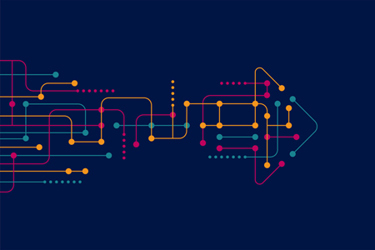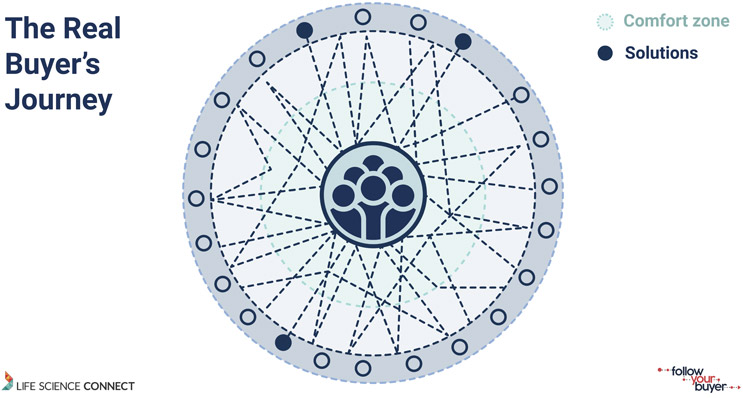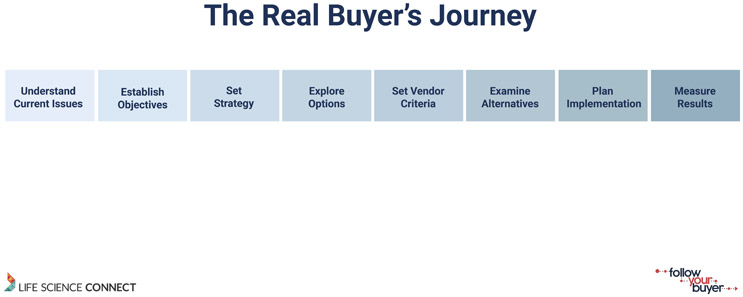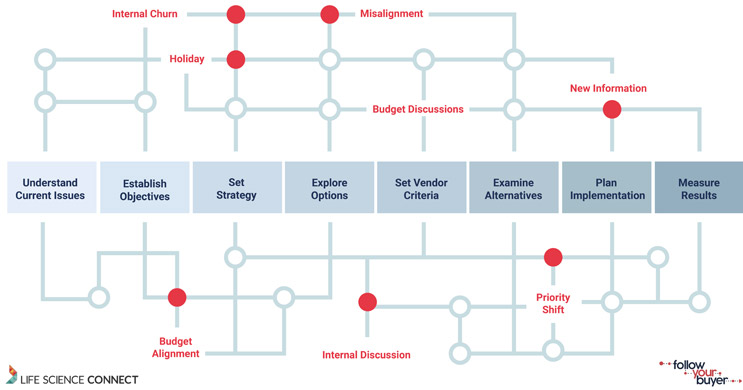The Real Buyer's Journey

By Perry Rearick, Chief Editor, Follow Your Buyer

The single force that has disrupted the way B2B solution providers market and sell is also the most critical to business success, buyers. As buyers discovered and embraced on-demand, digital content to help them solve problems, not make purchasing decisions, they pushed long-held B2B marketing traditions aside, rendering them obsolete.
Even though it is buyers who are demanding that sellers transform the way they market and sell, B2B organizations have been slow to accept the changes in buyer behavior, and even slower in adapting to new and better ways to communicate their value.
We’ve witnessed firsthand this transformation at Life Science Connect, the parent company of Follow Your Buyer. We learned that the buyer’s journey is much more complex than B2B sellers thought, and that buyers are navigating most of the journey without revealing themselves to potential sellers. We also learned that B2B companies that gained an understanding of the real buyer’s journey and were willing to adjust their approach to marketing and sales, were far more successful than those that did not.
The purpose of this article is to immerse ourselves into the real buyer’s journey and the eight stages that B2B buying teams go through as they try to solve problems and improve their businesses, which sometimes includes making a purchase.
The Seller’s Version of the Buyer’s Journey
The seller’s version of the buyer’s journey often has it begin when the buyer contacts a solution provider. And far too many B2B solution providers use this as a framework for their marketing and sales. The truth is that buyers are involved in problem solving activities far sooner than when they contact a vendor to consider buying something. Solution providers who seek engagement early and throughout the buyer’s journey are beating their competitors who wait until the late stages to engage target audiences.
The Buyer’s World
Buyers spend most of their time in an internal business comfort zone. See figure 1. Consider how you spend most of your time at work. Not to insult your intelligence, but are you waiting for a salesperson to contact you and then immediately jump onto a call so that you can buy something and spend money?

Your target audience is conducting routine business-as-usual activities. They have meetings to review key aspects of their business and they execute and supervise critical tasks. If they are a pharmaceutical contract manufacturer, that may mean reviewing customer outcomes data, quality management oversight, operational controls, and the state of regulatory compliance.
They operate in this internal comfort zone until they believe they have an issue. Then they intentionally venture outside it to better understand the issue and seek a solution. One thing to keep top of mind is that they are on a mission to solve a problem, and that may not include purchasing anything.
The buyer’s journey is not a clean linear process. Rather, members of problem-solving teams navigate their way through a network of helpful information and ultimately to a solution.
Eight Stages of the Real Buyer’s Journey
For better understanding, we’ve depicted the buyer’s journey as linear and consisting of eight stages. See figure 2. At first glance, you’ll think there are some steps missing, like when do they buy and sign the contract. This is the buyer’s journey, not the sellers process. As a seller, a signed contract may be your outcome. But for the buyer, their outcome is to solve a problem. The model we use comes from the book, “Selling to the C-Suite” by Nicholas A.C. Read and Stephen J. Bistritz.

Early Stages. The early stages of the buyer’s journey include understanding issues, establishing objectives, and setting a strategy. As I mentioned several times already, this is about solving problems from the buyer’s perspective.
For individuals and companies that have embraced continuous improvement, they will routinely spend time in these early stages of the buyer’s journey consuming information that may help them become aware of a problem they have, learn more about it, and better understand how it can be solved. They will seek information to help them understand how the problem is harming their business and what they stand to gain if it is solved.
The problem-solving team completes the early buyer’s journey with a clear vision for their project, essentially an outcome they want with success criteria.
Middle Stages. The middle stages of the buyer’s journey include exploring options, setting vendor criteria, and examining alternatives. During the middle stages, and using strategic guidance developed in the early stages, the problem-solving team explores various courses of action that will accomplish their objectives.
If the team determines they need support outside their organization, they will define the requirements and look at the options available to them. This may include contacting vendors to assess capabilities. And at the end of the middle stages, the problem-solving team will bring final options and recommendations to the entire team for a decision.
Late Stages. The late stages of the buyer’s journey include planning implementation and measuring results. Making a purchasing decision does not complete the buyer’s journey. Remember, they are trying to solve a problem. So, they must implement a solution to the issue uncovered in the early stages. And then, the buying team will measure results by circling back to the early stages and discerning if the results they are achieving are solving the problem.
It’s A Journey, Not a Process
Teams of problem solvers that meet your target audience personas are working through the eight stages of the buyer’s journey, but not perfectly. See figure 3. Buyer’s journeys encounter slowdowns, wrong turns, obstacles, and pauses to get directions.

What may appear like a stalled buying process may actually be any number of normal activities that occur in most buyer’s journeys. Consider the typical complex staffing action to introduce a major company initiative. Staffs will routinely take time for internal coordination meetings and to share new information. They may discover staff and budget misalignment and take the time to re-establish objectives and priorities. And every organization experiences personnel changes, and yes, they take holidays too. None of this means the buyer’s journey has ended, this is normal.
Conclusion
Enabled by digital information and empowered with knowledge acquired over the eight stages of the buyer’s journey, buyers know far more about sellers than sellers do about them. When they have their first conversation, if they even contact a seller, they do so from a position of informed authority. This has made traditional approaches to B2B marketing and sales ineffective.
Many B2B organizations have been slow to accept the changes in buyer behavior, and even slower in adapting to new and better ways to communicate their value. However, those sellers who understand the real buyer’s journey and gain a deep respect and appreciation for it, can begin to transform the way they market and sell, and will be far more successful than those who do not.
